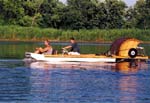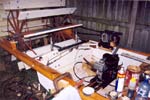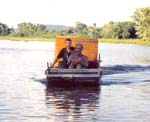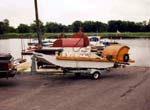 (click to enlarge)
(click to enlarge) |
We started building the sailboat
in Harry V.Sucher's book "Simplified Boatbuilding; The Flatbottem
Boat", got the hull done and put it in the barn out of the
weather. We got diverted by other things and twenty years later
noticed that it had the same basic hull shape as the bigger sternwheeler
so we changed horses in midstream and built the Bambino.
We had no plans but we did have
an idea, a few parts and a bunch of beer. After a few days we
had a boat in the water, more beer and odd looks from friends
and strangers alike.
The 4' diameter wheel was drawn
on a scrap of plywood, 1" angle iron was clamped to it and
then welded. Then 2 sets of spokes were welded to a 1" i.d.
galvanised pipe and 2 1" cold rolled steel stubs were welded
in the ends of the pipe to be supported by the 1" b.b. pillow
blocks which rested on the 3x4 beams bolted on the side of the
boat. The drive sprocket on the wheel is secured by a 1/4"
bolt which also acts as a shear pin. The wheel r.p.m. is roughly
30 when cruising.
 Engine Room (click
to enlarge)
Engine Room (click
to enlarge) |
The engine is a 5h.p. B+S engine
connected by belt to a 5 speed fwd. 1 rev. riding mower transmission,
which is connected by #40 chain to the wheel. 4th gear for downriver,
3rd for up, 2nd for power and in first gear it could slowly "caterpiller"
itself over sandbars with only an inch or so of water. The bottom
of the wheel and the bottom of the 2 rudders were flush with the
bottom of the hull.
All the parts for the craft came
from the marine division of Farm & Fleet Supply ,over by the
manure spreader accessorys, right next to cow tags and udder balm.
They didn't have a centrifical clutch for our engine in stock,
which was fine with me as the $69.95 they wanted was exactly the
price of the next batch of beer required in the construction process.
It's funny how things work out like that.
I got around being clutchless by
mounting the engine on channel iron that loosely gripped a 2x6.
A lever, rope and pulley arrangement would allow me to slide the
engine one way to engage the belt to the transmission and start
motovation, when the lever was unhooked, 2 springs from a backyard
trampoline would pull the engine back putting enough slack in
the belt to stop progress. This did allow the engine to be engaged
at any speed, including idle, which was handy, but it sort of
thwarted putting more mufflers on the engine which was really
#?!*ing loud and annoying.
 Twist (click to enlarge)
Twist (click to enlarge)
|
The boat itself was pretty flexible.
In the one picture (at left) from head on you can see it twisted
one way and it could also twist as much the other way. I put in
2 bulkheads crossways which didn't seem to make any differance,
maybe a coaming would have stopped that. It was odd steering in
reverse. It could go in circles one way but not the other. It
didn't seem to have anything to do with the twist. In 4th gear
full throttle the arms would be bobbing up and down,the hull twisting
back and forth and the bottom oil canning in and out like like
some snorting beast under a heavy burden.
We finished the outside with 2
coats of the best oil based primer and housepaint we could find
which didn't work very well at all except where the corners and
chines were glassed. The crappy b/c plywood we used probably didn't
help.
We had it on the Mississippi by
LaCrosse, Wis. and it did allright against the current even in
the main channel but made better progress on the sides in the
slack water, drawing only about 6" and going right over the
wing dams with no problems.
 (click to enlarge)
(click to enlarge) |
I believe the paddle wheel is a
pretty effecient means of propulsion compared to a propeller but
it is a lot more inconvienent. You don't want the boat rocking
side to side and you have to keep the boat trimmed right so the
paddles aren't too deep or to shallow. They're in the way at docks
and around other boats or brush and trees, they're top heavy,
stern heavy, not very manueverable compared to inboards and especially
outboards, plus in time of war they are too vulnerable to cannon
fire.
But if you have the stuff you
can build them cheap and repair them cheap, they are kind of indestructible
if built tough enough. Low tech. Shallow water capable. The bigger
the diameter of the wheel the more efficient as far as pushing
water backward as opposed to pushing it down or lifting it up.
Wooden buckets tend to get waterlogged if the boat sits in the
water a lot, tending to unbalance the wheel. I believe a boat
with a paddlewheel needs the bottom of the stern of the boat to
slope up as in the drawings to feed water to the wheel, give room
for the rudders and when in reverse let the water go under the
hull instead of just slapping against the transom.

|



